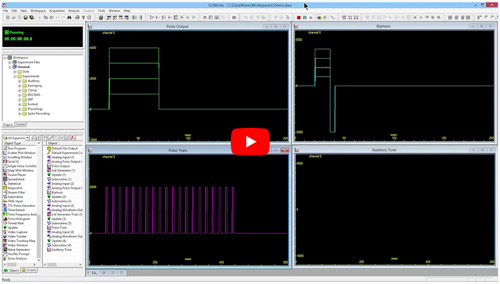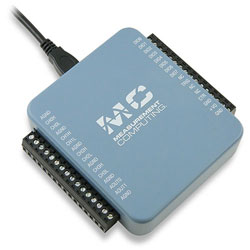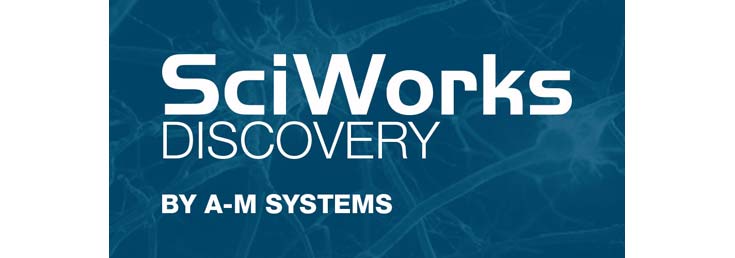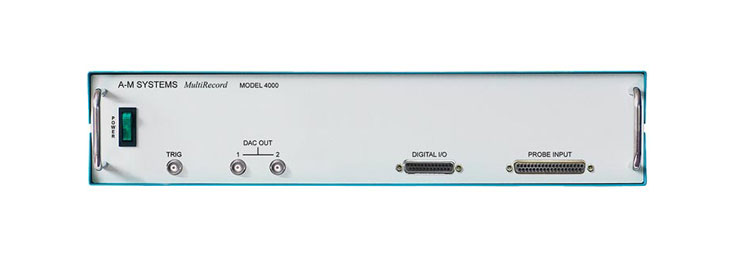SciWorks® Discovery
Comprehensive data acquisition and analysis software for any research protocol.
From 1 to 128 channels.
A-M Systems SciWorks Discovery software and advanced A/D hardware is the perfect complement to our low-channel count extracellular or intracellular amplifiers. It is designed to work with 1 to 8 single-ended channels of data. If you require more data processing capability, then consider our Discovery Pro system with more channels, optional video support, and a faster sampling rate. SciWorks Discovery is a real-time data acquisition, analysis, and instrument control application designed for a wide variety of electrophysiology experiments. It provides the user with a single interface to control instrumentation, perform real-time data analysis, including multi-unit spike sorting and separation, generate complicated stimulation patterns, and write data to a multiple of common industry-defined data formats.
Common applications include:
- Single-Unit Recording*
- Multi-Unit Recording*
- Evoked Responses
- Field Potentials
- EEG
- ECG / EKG
- ERG
- EMG
- Sleep Studies
- Behavior
- LTP / LTD
- Voltage Clamp
- Current Clamp
- Dose Response Curve
- Motor Unit Activity
- Intracellular Recording
- Respiration
- Pulse Oximetry
- Motion
- Blood Pressure
- GSR
- Brainstem Evoked Response
- Auditory Evoked Response**
- Video Capture and Analysis***
* Discovery is limited to 3 channels simultaneously of spike recording due to bandwidth considerations.
** Discovery Pro only
*** Discovery Pro only; requires optional VideoBench Module
Data acquisition and analysis processes are seamlessly integrated into a single software package. Users can define how the experiment should run, collect data, run complicated analysis tools, and store raw and analyzed data all at the same time — without having to change software packages.
Discovery can be paired with a BNC breakout box providing direct access to the most critical connections of the A/D card or a screw-terminal accessory for a less expensive solution.
SciWorks® SciWorks Discovery Pro Data Acquisition And Analysis System
While SciWorks Discovery is the ideal data acquisition and analysis system for most electrophysiology experimental protocols, there are situations where upgrading to Sciworks Discovery Pro makes scientific and financial sense. If you are interested in acquiring and processing more than 8 channels of data, then upgrading to one of our SciWorks Discovery Pro options can give you access to up to 128 channels of capability. SciWorks Discovery’s underlying 8-channel data acquisition card’s clockrate is sufficient to generate simple stimuli. However, if your experimental protocols require delivering complicated stimulus trains, or auditory stimuli, then it is recommended to upgrade to SciWorks Discovery Pro. Finally, if your research protocols involve capturing, measuring, and analyzing video data, then SciWorks Discovery Pro with the optional VideoBench add-in is the software package to be used.
Upgrading to SciWorks Discovery Pro is also cost effective. While you can pay a price difference later to upgrade from the Discovery to the Discovery Pro software package, it is necessary to purchase the required a/d hardware that supports Discovery Pro at full price. Thus, purchasing Discovery Pro upfront means not double paying for acquisition hardware systems.
Features of Discovery vs. Discovery Pro
While SciWorks Discovery is the ideal data acquisition and analysis system for most electrophysiology experimental protocols, upgrading to Sciworks Discovery Pro enables the scientist to use the tools of Sciworks for more channels of data, to generate more complicated stimulation sequences and waveforms, and to incorporate video acquisition and analysis.
Upgrading to SciWorks Discovery Pro is also cost effective. While you can pay a price difference later to upgrade from the Discovery to the Discovery Pro software package, it is necessary to purchase the required a/d hardware that supports Discovery Pro at full price. Thus, purchasing Discovery Pro upfront means not double paying for acquisition hardware systems.
Applications
SciWorks Discovery and Discovery Pro can be configured to run any of the following experiments, and countless others.
The following list contains only a few examples of the variety of experiments SciWorks Discovery can perform and analyze.
Click on the section headings for details and videos regarding how SciWorks can be used in your lab to measure average responses, measure population spike amplitudes, perform Fourier analysis to obtain a power spectrum, interval measurements, detect seizures, and perform many other protocols. Adding VideoBench to either Discovery Pro bundle enables video collection and analysis functionality.
Data Acquisition
An experiment is defined using the built-in tools of SciWorks Discovery or Discovery Pro. These tools are oriented around common experiment tasks, such as data acquisition, stimulus generation and delivery, data display, data analysis, annotation of data, timing, and external device control.
SciWorks Discovery Or Discovery Pro provides the user with a single interface to:
- Control instrumentation
- Define acquisition parameters such as sampling rates and gain factors
- Perform real time data analysis
- Coordinate timing among multiple external instruments
- Generate complicated stimulation patterns
- Annotate data files with messages, trial information, and timing flags
- Write data to a multiple of common industry defined data formats
Data Acquisition (Analog and Digital Input)
- Discovery Pro 64: Acquire from 1 to 64 channels of continuous single ended ("no gap") or discrete ("sweep" mode) data (up to 128 with additional units).
- Discovery Pro 16: Acquire from 1 to 16 channels of continuous single ended ("no gap") or discrete ("sweep" mode) data
- Discovery 8: Acquire from 1 to 8 channels of continuous single ended ("no gap") or discrete ("sweep" mode) data
- Independent sampling rate and A/D gain settings per channel (Discovery Pro bundles only)
- Record both acquired and analyzed data to disk for off-line processing
- All data items are timestamped to 1 microsecond resolution for experiments lasting hours, days, weeks with a high-resolution clock
Stimulus Generation and Analog/Digital Output
- Generate stimuli and acquire data at the same time
- A stimulus "List Generator" automates stimulus output and provides both random, pseudo-random and fixed output
- Generate analog waveform output for auditory or behavioral queuing. (* Discovery Pro only)
- Play and manipulate .wav files for auditory stimulation (* Discovery Pro only)
- Programmable counter/timers interface for complex pulses or pulse trains

Stimulus Generation and Data Acquisition in SciWorks
Experimental Control, Execution and Timing
- Dynamically change experiment parameters while the experiment is executing
- Conditional experiment execution based on experimental results and external equipment
- Timers, counters and looping controls for automated experimentation
- Read/Write to multiple digital ports for experiment control
- Customizable windows for displaying both acquired and analyzed data in real-time
- Extensive updating capabilities of stimulus, counter, digital I/O in trial markers, with simultaneous recording of data
- External triggering of data acquisition using TTL triggering or Digital I/O
Experimental Design and User Interaction
- Complex experimental protocol can be easily created using a combination of events and objects with common defaults and intuitive settings
- Design your own menus and dialogs to use during real-time and file playback
- Design status warnings when settings are incomplete or incorrect even before execution
- Real-time logging of experiment protocols and execution
Data Analysis
SciWorks Discovery or Discovery Pro software enables real-time data-analysis while not interrupting data acquisition.
Spike records can be sorted using the AutoSort module, or sorted by a user driven analysis process. Separated spikes can then be catalogued and quantified for use in rasters, histograms, rate calculations, etc.
EEG records can undergo Fourier analysis online.
Population spikes can be measured.
And all of the analyzed data can be stored at the same time as the raw recordings.
Find something interesting in a review of the analyzed data, but need to go back to the original for a re-analysis? No problem. You can call up the entire record, and start anew. Or, you can instantly jump to a particular time stamp, or experiment marker, without having to load in the entire record.
Features:
- All Analysis can be performed while data is being acquired or from file playback
- Detect and extract events based on software window discriminators
- Real-time Multi-Unit Spike Sorting & Separation
- Extract key waveform parameters such as peak, valley, area, dV/dt, and many others
- Waveform averaging
- Event or spike triggered averaging
- Digital filtering
- Detect waveform bursts
- Detect spike/event bursts
- Rate meters and rate gauges
- Firing rate grids
- Perievent time (PETH), Inter-event interval (IEIH) histograms and Dot Rasters
- Cross Correlation Histograms
- Continuous Event interval analysis
- Signal conditioning such as auto-baseline and waveform smoothing
- Statistical calculations for waveform and single value data
- Fourier Analysis including various power calculations
- Sonograms and spectrograms
- Statistical distribution analysis and display
- Acquire to a real time spreadsheet for custom analysis and reporting
- Analysis for custom multi-array and multi-channel electrode analysis for tetrodes, stereotrodes and multi-array electrodes
- Perform math operations defined by custom equations to operate on single value or array data (i.e. histograms or waveforms)
- Curve fitting of single values
File Output and Data Replay
- Write to or read from one or more files simultaneously during experimentation
- High performance file format allows for multiple data types (including raw, analyzed and markers) to be saved to the same file
- Multiple formats supported for both import and export (i.e. DDF, WorkBench, Discovery, ABF, CED, Neuralynx, Plexon, EDF, NEV, Neuroshare, and ASCII)
- Data can be replayed from file just as it was acquired using slower, actual, or faster timing
- Drag & Drop, Copy & Paste complete files or selected data for replay and analysis
Current System Requirements:
- Windows 10 or Windows 7, 32 or 64 bit
- 35 MB free disk space for installation
- Additional free disk space for data files (experiment dependent)
- USB 2.0 or greater
- CPU speed and memory requirements can vary depending on experiment protocol
Hardware
Sciworks Discovery requires an A/D card for proper operation. The A/D card can be purchased in a convenient breakout box giving you full access to all features of the data acquisition input\output device, including all analog input and output channels, all digital input and output channels, and assorted clocks and triggering ports. It is also available in a standalone screw terminal style USB enclosure.
Specifications for the Discovery A/D card is listed below.
These bundles include cabling from the breakout box to your computer, but do not include BNC cables or ganged input/output cables.
959608 SciWorks Cables-DA-8 Digital I/O Cable With Bare Endings (1 m)
959664 SciWorks Cables-DA-16 or DA-64 Digital I/O Cable With Bare Endings (1 m)
959636 SciWorks Cables-Model 3600 to Ganged Analog Input Cable (1 m)
959635 SciWorks Cables-Model 3500 to Ganged Analog Input Cable (1 m)
8-Channel A/D Card Specifications
Analog Input
- DA8: Either 8 Single Ended or 4 Differential Analog Input Channels
- 16-Bit Resolution
- 100 kS/s Maximum Aggregate Sample Rate
- Input Range: ± 10 V
Analog Output
- 2 Channels of Analog Output
- 16-Bit Resolution
- 5 kS/s Maximum Sample Rate
Digital Input / Output
- 8 Channels
- 1 Counter / Timer


Sciworks Discovery Pro comes bundled with a convenient breakout box giving you full access to all features of the data acquisition input\output device, including all analog input and output channels, all digital input and output channels, and assorted clocks and triggering ports.
Specifications for the respective SciWorks Discovery Pro 16 and SciWorks Discovery Pro 64 channel systems are listed below.
These bundles include cabling from the breakout box to your computer, but do not include BNC cables or ganged input\output cables. Those can be purchased separately.
16 / 64-Channel A/D Card Specifications
Analog Input
- DA16: Either 16 Single-Ended or 8 Differential Analog Input Channels
- DA64: Either 64 Single-Ended or 32 Differential Analog Input Channels
- 16-Bit Resolution
- 1 MS/s Maximum Sample Rate
- Seven ranges of sensitivity, from ± 100 mV to ± 10 V
Analog Output
- 4 Channels of Analog Output
- 16-Bit Resolution
- 1 MS/s Maximum Sample Rate
Digital Input / Output
- 24 Channels
- 4 Counters
- 2 Timers
- Optional Ganged Input-Output Cable available


Related Products:






